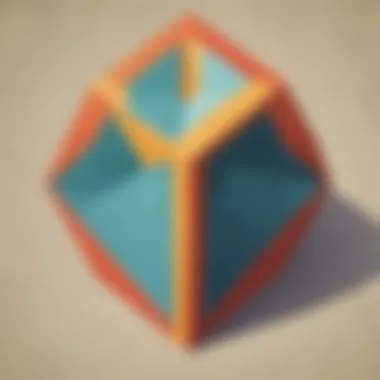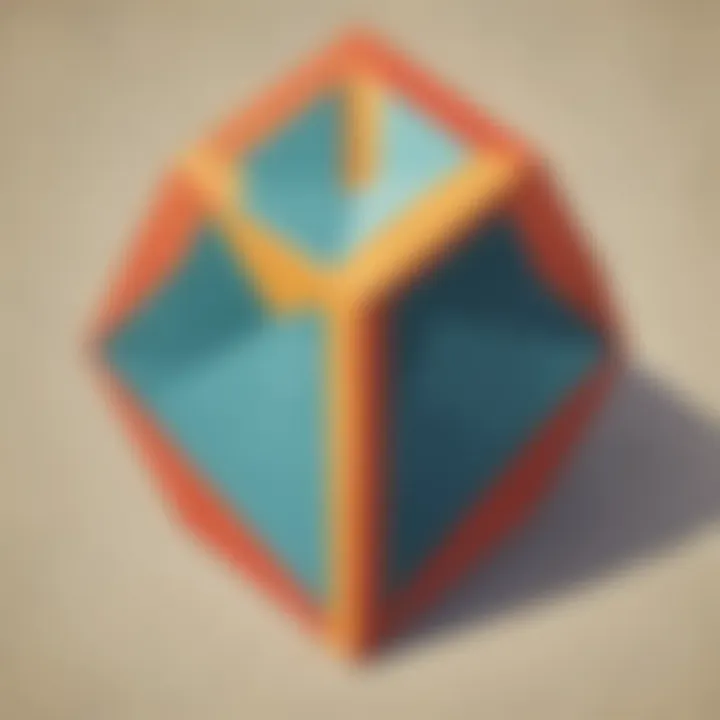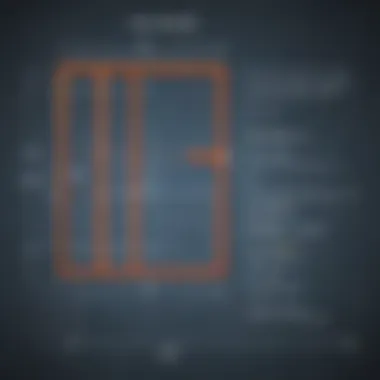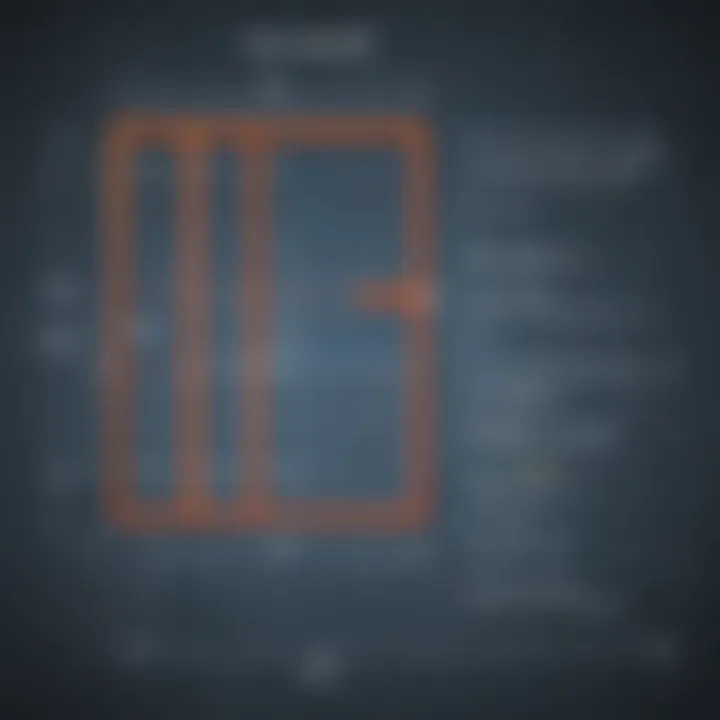Mastering Perimeter: A Comprehensive Guide


Intro
When it comes to mathematics, perimeter is like the invisible fence that outlines different shapes. Every time we're measuring the edges of a square, rectangle, triangle, or even more complex figures, we are essentially calculating the perimeter. Understanding this concept can help children not only grasp the basics of geometry but also build a solid foundation for more complex mathematical ideas in their future.
So why should elementary school students be particularly interested in perimeter? Well, it’s not just about numbers; it’s about problem-solving in real life, too. From fencing a yard to wrapping a gift, perimeter calculations come in handy. This article will break down perimeter in a straightforward manner, sharing formulas and fun applications that young learners can relate to. In the sections following this, we will explore a range of engaging activities, tests to bolster confidence, and further educational resources to further enrich understanding.
Let’s dive in!
Prelims to Perimeter
Understanding perimeter is like opening a doorway to the world of shapes. This fundamental concept not only serves as a building block for further geometry studies but also has practical implications in daily life. It lays the groundwork for various mathematical endeavors, helping young learners comprehend more complex theories in the future. In this article, we’ll explore the ins and outs of perimeter, unlocking its significance through definitions, formulas, and real-life applications that resonate with students and anyone curious to learn.
Defining Perimeter
Perimeter, in simple terms, refers to the distance around a two-dimensional shape. Imagine you�’re walking around a park; the path you take would represent the perimeter. For example, consider a rectangle. To find its perimeter, you need to add up all the sides: for a rectangle with length and width, the formula is P = 2(length + width). This straightforward definition provides a strong foundation for visualizing how shapes are structured and understood.
But let’s think broader. When you calculate the perimeter of a triangle, you add the lengths of all three sides. If each side measures 3, 4, and 5 units, the perimeter would be P = 3 + 4 + 5 = 12 units. Through these examples, we see that perimeter measures how much space a shape encloses, which leads to a better grasp of geometry as a whole.
Importance of Understanding Perimeter
The concept of perimeter is crucial beyond just numbers and formulas. Grasping how to calculate it enables learners to see the relationships between different shapes and appreciate the geometrical world around them.
- Real-World Applications: From fencing around a garden to figuring out how much border material is needed for a quilt, perimeter calculations come in handy.
- Problem-Solving Skills: Tackling perimeter problems enhances logic and reasoning abilities, vital for mathematics and everyday decision-making.
- Foundation for Advanced Geometry: Comprehending perimeter is essential before progressing to area and volume calculations. It’s a stepping stone; without it, deeper geometric concepts can be a tough nut to crack.
Perimeter isn’t just about finding distances; it’s about connecting dots in the geometric puzzle.
In summary, a solid foundation in understanding perimeter equips students not only for academic success but also for practical activities that require planning and measurement. As we move forward, we’ll dive into basic concepts in geometry, further enriching our knowledge about shapes and their boundaries.
Basic Concepts in Geometry
Understanding geometric concepts is like laying down the tracks before a train ride; without a solid foundation, one can easily get lost. Basic concepts in geometry are essential not just for academic purposes, but for everyday decision-making too. Knowing the fundamental aspects of geometry aids in visualizing problems and finding solutions more efficiently. It also cultivates critical thinking skills that can be applied to various subjects and real-world scenarios.
Points, Lines, and Shapes
At the very heart of geometry are points, lines, and shapes. Every geometric figure starts with these components. A point can be seen as a precise location in space, represented by a dot. It’s fundamental yet powerful. Lines extend infinitely in both directions and are straight. They can connect two points or serve as boundaries for shapes. Shapes are the combinations of points and lines; they form the visual structures we interact with in our daily lives.
Understanding these basic elements allows us to grasp more complex shapes and their properties. For instance, if you know what a line is, you can better understand how multiple lines create angles or triangles. This is crucial for solving perimeter problems, as you often deal with the boundaries formed by these shapes.
Types of Geometric Shapes
Moving forward, geometric shapes can be broadly categorized into two main types: Two-Dimensional Shapes and Three-Dimensional Shapes. Each has its own unique properties and relevance.
Two-Dimensional Shapes


Two-dimensional shapes are flat and have width and height but no depth. Think of simple figures like squares, rectangles, and circles. One key characteristic of two-dimensional shapes is that they can be easily measured, allowing for simple area and perimeter calculations. Their simplicity makes them an ideal choice for this article, especially when discussing perimeter.
These shapes are crucial when you need to outline areas, such as a piece of paper or a room’s flooring. The unique feature of two-dimensional shapes is that they can be drawn on a flat surface, which means that many of the rules of geometry apply straightforwardly. However, they also come with their pitfalls—some may struggle with visualizing how these shapes exist in real life, making calculations seem abstract.
Three-Dimensional Shapes
Three-dimensional shapes add another layer of complexity; they possess depth in addition to width and height. Common examples include cubes, spheres, and pyramids. These shapes play a significant role in many real-life applications, from packaging design to architecture. A key characteristic of three-dimensional shapes is that they can hold volume, making them essential in fields like engineering.
What sets three-dimensional shapes apart is their ability to provide a realistic representation of objects. However, calculating their perimeter often requires understanding concepts such as surface area or circumference, which can confuse some learners. This complexity emphasizes the importance of mastering two-dimensional shapes first, as they serve as building blocks for comprehending three-dimensional geometry.
Understanding both two-dimensional and three-dimensional shapes helps students visualize real-world objects, creating a connection between theory and reality, crucial for mastering perimeter.
Formulas for Calculating Perimeter
Calculating the perimeter is a fundamental skill in geometry that can help students make sense of the spaces they live in. Knowing how to find the perimeter of various shapes not only strengthens numerical understanding but also aids students in real-world applications like measuring a garden, planning a fence, or laying out a sports field. This section aims to clarify this essential concept and provide precise formulas for common shapes. By mastering these basics, students can apply their knowledge with confidence and tackle more complex mathematical challenges as they arise.
Perimeter of Common Shapes
Understanding the perimeter of common shapes forms the backbone of practical geometric application. Each shape carries its own unique aspects that contribute to how we calculate their perimeters.
Rectangle
A rectangle is a four-sided shape where opposite sides are equal in length. To find the perimeter of a rectangle, the formula is simple: add together the lengths of all four sides or, more concisely, use the formula: ( P = 2 \times (length + width) ). The key characteristic of rectangles is their straightforwardness, making them a beneficial shape for learners.
One unique feature of rectangles is that the width and length can vary infinitely, offering flexibility in problem solving. However, it can also lead to confusion when students mix up dimensions, so clarity is essential in teaching these concepts.
Square
A square is a special type of rectangle where all four sides are equal. To find its perimeter, one simply multiplies the length of one side by four: ( P = 4 \times side ). This simplicity makes squares a popular choice for educators teaching perimeter.
The equal sides of a square mean there's less opportunity for error, which can be encouraging for young learners. On the flip side, students sometimes overlook the unique nature of squares, treating them as mere rectangles, which can oversimplify their understanding of geometric properties.
Triangle
Triangles bring different angles into play, consisting of three sides. The formula for calculating the perimeter is to simply add the lengths of all three sides: ( P = side1 + side2 + side3 ). Triangles are particularly helpful in illustrating concepts of difference in lengths and the effects on perimeter, helping young minds grasp basic additions and comparisons.
The distinct characteristic of triangles is that even with varied side lengths, they still can form a perimeter with a clear definition. However, students often struggle with identifying isosceles, equilateral, or scalene triangles, which can create challenges in calculating perimeter correctly.
Circle
A circle is unlike any polygon, as it does not have straight edges or corners. The perimeter of a circle is referred to as its circumference, calculated with the formula: ( C = 2 \times \pi \times radius ) or ( C = \pi \times diameter ). The circle's smooth, curved nature and its unique approach to measuring distance within its boundary make it an intriguing shape for students.
One advantage of circles is the consistency in their formula, promoting foundational understanding of pi (approximately 3.14). However, students sometimes find it challenging to grasp the concept of radius and diameter, especially if they lack a solid foundation in more basic shapes first.
Understanding the Formula Components


Getting into the nitty-gritty, it’s vital to break down each component of the formulas used for perimeter calculations. This includes elucidating the significance of length, width, height, and radius, as well as how they interlink with geometric shapes. This comprehension provides students not only with the tools needed for calculations but also encourages them to appreciate how these values affect the overall shape and how adjustments to one dimension can consequences for the perimeter. Understanding the relationships between different dimensions will drive home the importance of accuracy in geometric calculation and prepare students for more complex math ahead.
Real-Life Applications of Perimeter
Understanding the concept of perimeter is not just a theoretical exercise; it plays a pivotal role in a myriad of real-life scenarios. When we think of perimeter, we often associate it with shapes and lines, yet its applications stretch far beyond the classroom. From the layout of our homes to the design of community spaces, knowing how to calculate perimeter enhances our ability to navigate various environments with confidence.
Bounding Spaces
Bounding spaces refers to the ways we utilize perimeter calculations to establish boundaries. This is particularly important in urban planning and property management. For example, when someone buys a new house, they need to understand the piece of land they own, which is where perimeter comes in. Knowing how much land is owned helps homeowners determine how much space they have for things like adding a pool or building a deck.
Additionally, schools may rely on perimeter measurements to plan safe play areas for children. Ensuring that the playground is securely enclosed makes all the difference in keeping kids safe and happy during recess.
"An understanding of perimeter can transform how we approach boundaries in our lives, from personal property to communal spaces."
Design and Construction
When it comes to design and construction, knowing the perimeter of an area is absolutely critical. Architects and engineers use this measurement to decide how much material will be needed for construction projects. For instance, if someone is building a fence around a backyard, calculating the total perimeter allows them to determine how many fence panels to purchase. This not only saves money but also minimizes waste.
Moreover, in commercial settings, businesses often need to plan layouts for offices or retail spaces. The perimeter can affect things like traffic flow and customer access. By thinking through the perimeter aspect early in the design process, one can effectively optimize how the space is used.
Landscaping and Gardening
In the world of landscaping and gardening, calculating the perimeter is essential for planning any garden layout. Homeowners interested in planting a new flower bed must know the perimeter to understand how many plants they can fit in that space. It also helps in calculating the amount of mulch or soil needed to fill the area.
Additionally, gardeners often need to establish boundaries between different plants or garden sections. A well-measured perimeter can assist in creating aesthetically pleasing designs that are easy to maintain while ensuring that different plant types do not encroach on each other’s space. This balance is vital for successful gardening and achieving a harmonious outdoor space.
In all these areas—bounding spaces, design and construction, and landscaping—perimeter calculations bring clarity and efficiency. By grasping how to solve for perimeter, one masters an essential tool that can be applied in daily life, enriching it with thoughtful planning and awareness.
Strategies for Solving Perimeter Problems
Step-by-Step Approach
A step-by-step approach can be a guiding light when faced with perimeter problems. Just as a recipe tells you how to bake a cake, following a structured method can turn what's often perceived as daunting into a piece of cake. Let's discuss how the process typically looks:
- Identify the Shape: Recognizing the shape you are working with is crucial. Is it a rectangle, square, triangle, or maybe something more complex? Knowing the shape helps determine which formulas to apply.
- Gather Measurements: Make sure you have all the necessary dimensions. For instance, you might need the length and width of a rectangle or the lengths of all sides of a triangle. If measurements are missing or unclear, clarify them first.
- Select the Appropriate Formula: Choose the right formula based on the identified shape. For example:
- Carry Out the Calculations: Use your gathered data to compute the perimeter. Be methodical and double-check each arithmetic operation to avoid careless errors.
- Interpret the Results: Once you have the answer, think about what it means in context. Does it fit the scenario you're dealing with?
- Rectangle: Perimeter = 2 x (length + width)
- Square: Perimeter = 4 x side length
- Triangle: Perimeter = sum of all sides
- Circle: Perimeter (circumference) = 2 x π x radius
"Taking things step by step is a great way to keep confusion at bay."
Common Mistakes to Avoid
While learning about perimeter, it's easy to stumble over some common missteps. Awareness of these pitfalls can save time and frustration. Here are a few frequent mistakes to keep in mind:
- Neglecting Units: Forgetting to keep track of units can lead to incorrect answers. Always ensure you're working with the same units, like converting inches to feet if necessary.
- Omitting Measurements: Sometimes, students might have only some measurements needed for the calculation. Don’t make assumptions! Having all the information is key.
- Using Wrong Formulas: Remember to pick the right formula for each shape. Confusing perimeter with area is a classic mix-up, so be aware of the differences.
- Rushing the Calculation: Eager students might skip double-checking their work. It’s better to take a moment to verify calculations than to rush and make mistakes.
- Forgetting to Consider Complex Shapes: Not all shapes are straightforward. Sometimes, a shape might be a combination or needs parts to be added together. Always break them down into simpler shapes if needed.


By implementing these strategies and being mindful of common mistakes, students can effectively navigate perimeter problems while boosting their mathematical confidence. The journey of understanding perimeter takes patience, practice, and a willingness to learn. With these tools in hand, anyone can tackle the challenges that come with finding perimeter.
Challenges in Perimeter Calculations
Understanding how to calculate perimeter comes with its fair share of hurdles. It's not just about plugging numbers into a formula; some situations require deeper comprehension. Grasping these challenges can help young learners and parents alike to navigate the complexities of geometry with confidence.
Complex Shapes
One of the main obstacles in perimeter calculation lies in dealing with complex shapes. Unlike basic figures like squares or circles, complex shapes can come in various forms, sometimes resembling a jigsaw puzzle. Consider, for instance, a shape composed of a rectangle and a semicircle. Breaking down this amalgamation demands careful attention.
To solve for the perimeter of such a shape, students must first identify the individual components and their specific measurements. Here's how one might approach it:
- Identify each part: Recognize the distinct shapes that make up the compound figure.
- Calculate separately: Use the appropriate formulas for each individual shape. For example, the perimeter of a rectangle includes both length and width, while a semicircle requires knowledge of the radius.
- Combine thoroughly: Once the perimeter of each component is found, combine these values to find the total perimeter.
Arithmetic skills become your best friends here. Keep an eye on those numbers, ensure they match up nicely without missing anything, and you’re on your way to mastering even the most tangled shapes. Echoing this sentiment, one might say, "Many hands make light work," reminding students that seeking help is also a wise choice when treading into tougher math waters.
Changing Units
Unit conversion is another common challenge faced by learners when calculating perimeter. Think about it: measuring a backyard might use feet while drawing a blueprint for landscaping may call for inches. Mixing these measurements can throw off the results faster than a cat high-tailing it from a dog!
Here’s a quick guide to avoiding the pitfalls when facing unit changes:
- Know your units: Become familiar with measurement units like inches, feet, yards, and meters.
- Convert as needed: When switching from one unit to another, make sure your conversions are correct. For instance, remember that 1 foot equals 12 inches; it’s a simple swap but can lead to giant errors!
- Stay consistent: Decide on a unit to use before beginning your perimeter calculations. Stick with it to keep things tidy and clear.
By effectively managing unit conversions, students can alleviate confusion and maintain accuracy. As the saying goes, “a stitch in time saves nine,” emphasizing that preventative measures are worth it in the long run.
% Calculating perimeter, in both complex shapes and varying units, can be tricky but is achievable with careful planning and practice.
End: Mastery of Perimeter
In wrapping up our exploration of perimeter, it's essential to recognize the integral role it plays in various fields, as well as in everyday life. Mastering perimeter calculations is not just an academic exercise; it's a skill that extends far beyond the classroom. When children grasp these concepts, they gain a powerful tool for understanding the world around them.
Reviewing Key Concepts
To solidify the knowledge acquired throughout this article, let’s revisit the key concepts of perimeter:
- Definition: The perimeter is the total distance around a shape. Whether it’s a square, rectangle, or circle, knowing how to measure it is fundamental.
- Formulas: Different shapes have distinct formulas for perimeter. For instance, a square's perimeter is calculated by multiplying one side length by four, while the perimeter of a rectangle involves adding together the lengths of all four sides.
- Real-Life Applications: From calculating how much fencing is needed for a garden to understanding the dimensions of a room, perimeter plays a role in a variety of practical scenarios.
- Common Pitfalls: When working with shapes, it's easy to forget to include all sides or to mix up units, which can lead to skewed results. Recognizing and avoiding these missteps is crucial for accurate calculations.
"Understanding perimeter isn’t just about numbers; it’s about building awareness of space and dimensions that truly enriches our grasp of the physical world."
By reviewing these points, learners can ease the cognitive load when faced with perimeter problems in the future. It secures the foundation needed for more complex topics, like area calculations and even understanding volume.
Encouraging Further Exploration
After grasping the essentials of perimeter, further exploration can ignite a genuine passion for geometry. Here are some ideas for encouraging deeper engagement with the subject:
- Hands-On Activities: Engage in activities like measuring the perimeter of familiar objects around the house or yard. This could include frames, books, or doghouses. Letting kids take measurements reinforces their learning.
- Explore Art and Design: Encourage children to create geometric art. Using various shapes to design patterns can not only help with understanding perimeter but also introduce concepts of area and symmetry.
- Real-World Problems: Challenge them to use perimeter calculation in planning. For instance, if they want to build a small garden, they can design the layout and calculate how much fencing they would need.
- Interactive Resources: Consider using educational games and apps focused on geometry. Websites like en.wikipedia.org and britannica.com offer a wealth of resources on geometry that can be both fun and informative.
Engaging with perimeter through varied lenses can lead to a deeper understanding of math’s relevance. Geometry often inspires curiosity about shapes and space that lays a path toward broader mathematical concepts.
Mastery of perimeter is just the beginning. As we venture beyond basic calculations, we open doors to critical thinking, spatial awareness, and problem-solving, essential skills in our fast-moving world.







